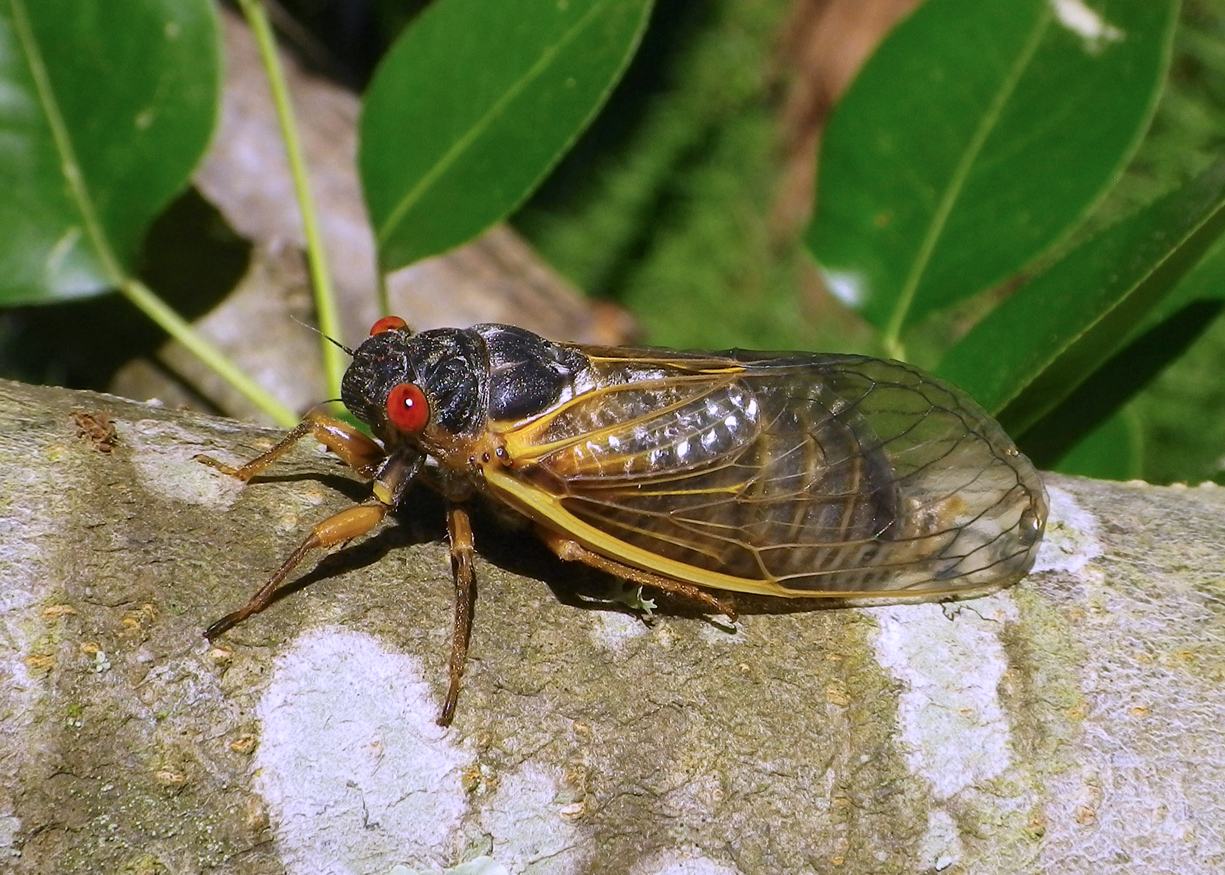
by Kate Redmond
The Cicadas are Coming a Tale in Four Parts
Greetings BugFans,
The insect world is gearing up to stage an event that is the entomological equivalent of the recent total solar eclipse. The buzz (if you’ll pardon the term) began a few months ago with articles in the New York Times and the Smithsonian newsletter. The event: the emergence of billions (with a “b”) of Periodical cicadas over a large chunk of the country south and east of Wisconsin. What one entomologist calls a “spectacular, macabre Mardi Gras” and another calls “a David Attenborough show in your backyard.”
Part 1: SETTING THE STAGE
Young cicadas – nymphs – live underground, using their piercing-sucking mouthparts to feed on the fluid that’s getting pumped up into the tree from the roots. The length of their subterranean stay is determined by their species (though sometimes over-enthusiastic individuals may jump the gun, and climate change may be affecting their internal chronometers).
Most of Wisconsin’s cicada species are green and black, bullet-shaped Annual cicadas in the genus Neotibicen, the Dog-day cicadas https://bugguide.net/node/view/1588994/bgimage, who spend just a year or two underground as nymphs and then tunnel to the surface, climb something vertical, and emerge from their nymphal skin into adulthood (great photo series here https://bugguide.net/node/view/320141/bgimage). If you’ve seen a nymph trekking across the lawn or climbing a post, you’ve been privileged to see something that looks, and is, prehistoric – they’ve been around for 200 million years.
Cicadas practice what the BugLady calls the “Normandy Beach” strategy of reproduction – throw enough soldiers on the beach and some will get through (real scientists call it “predator satiation”). Cicadas emerge in large numbers into the waiting jaws, bills, claws, and skillets of a myriad of predators. Another hypothesis involves predator avoidance. The year after the cicadas are numerous, their predators’ populations peak, because they had all that food last year to feed to all those young, and survival rates were high. The next year, prey is scarce, and predator numbers adjust themselves (a 13 or 17 year lag seems overly cautious, but there are Prime number variants of this theory that the BugLady is not equipped to explain). Or it could be that cicadas developed this method to avoid hybridization.
Part 2: PERIODICAL CICADAS (Magicicada sp.), aka 13 and 17 YEAR LOCUSTS.
First off, they’re not locusts – locusts are in the Grasshopper order Orthoptera, and cicadas are in the Bug order Hemiptera. Second, although most cicadas have relatively predictable nymphal periods, the genus Magicicada owns the name “Periodical cicada.” North America has three species of 17-year cicadas and four species of 13-year cicadas (and of course, some cicada experts think that those seven Magicicada species might only be three species. Stay tuned). The ranges of the 17-year species are a bit more northern, and the 13-year species are a bit more southern. Third, they’re pretty awesome-looking insects. Many thanks to BugFan Tom for his wonderful pictures.
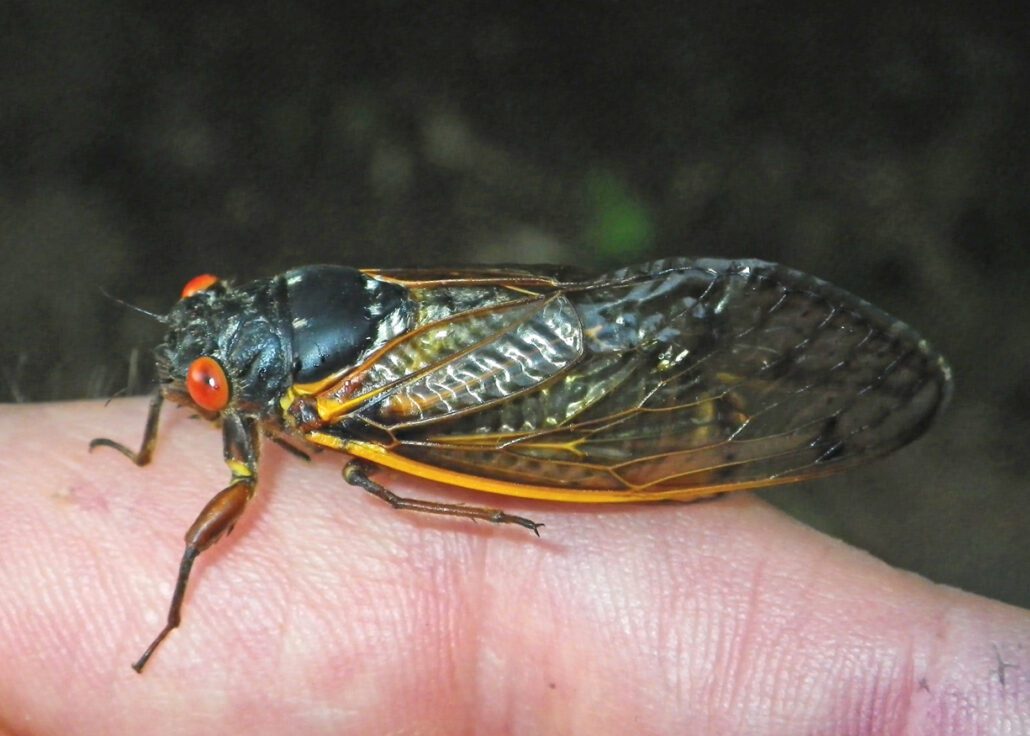
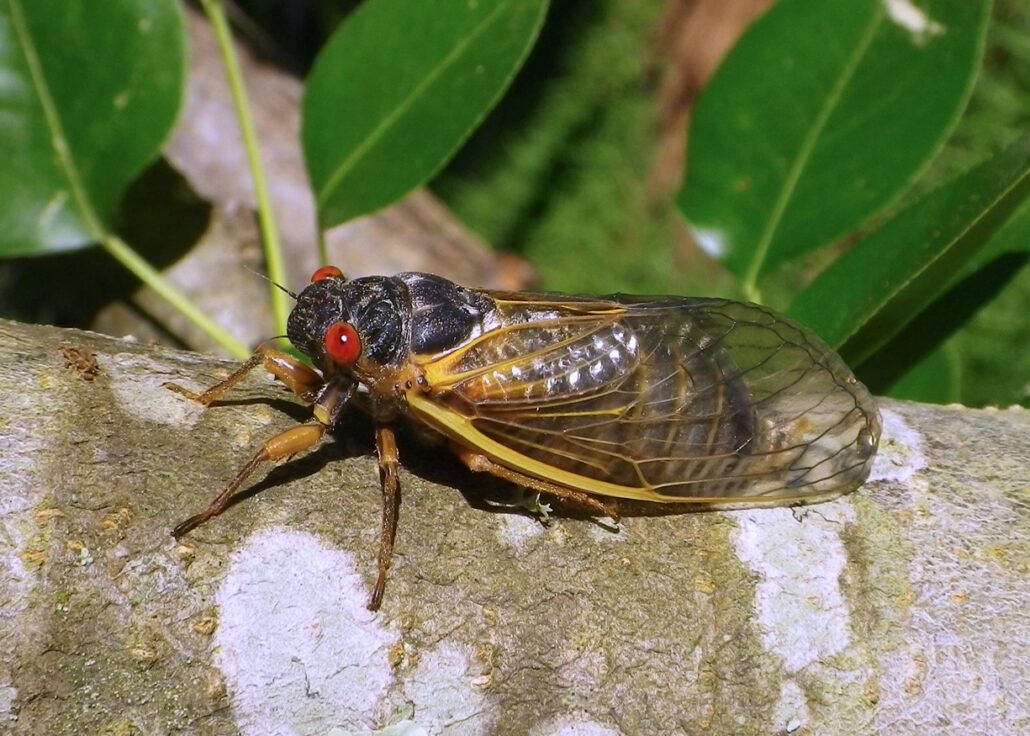
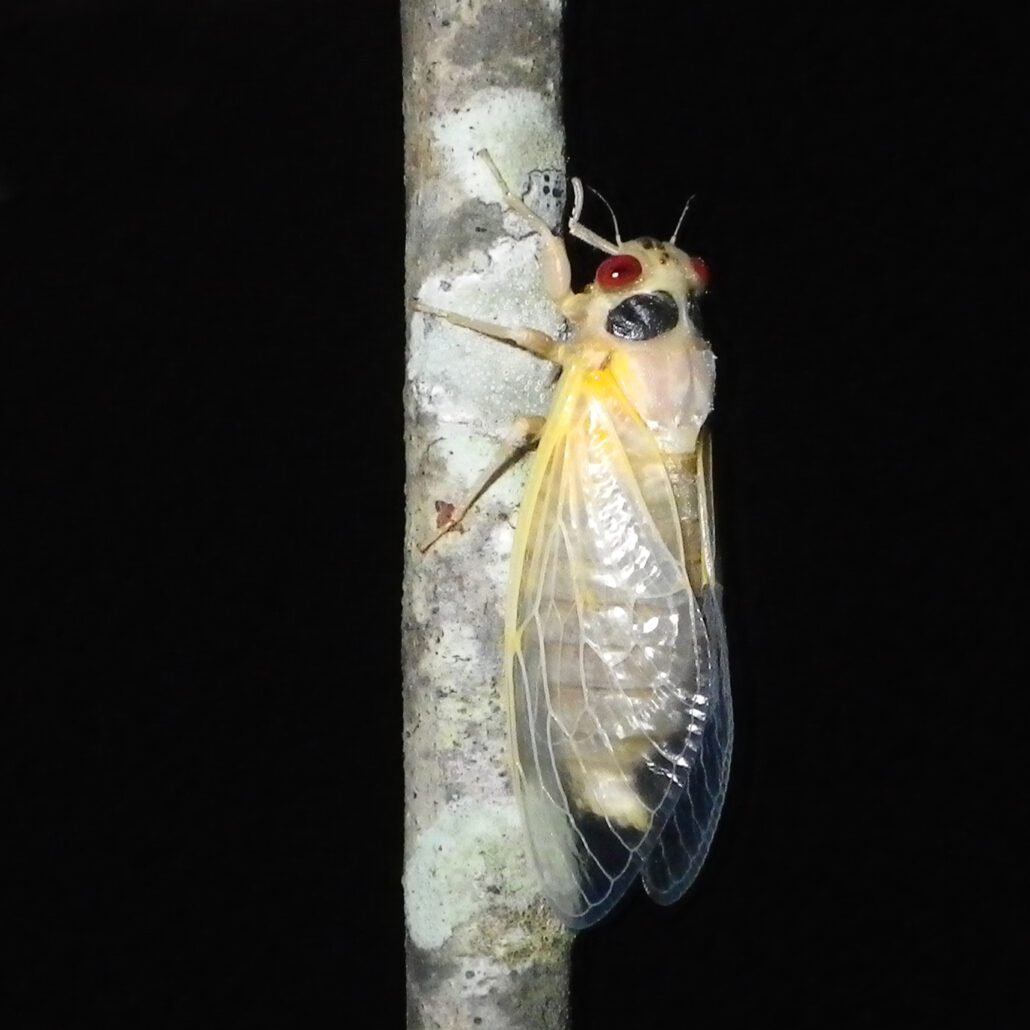
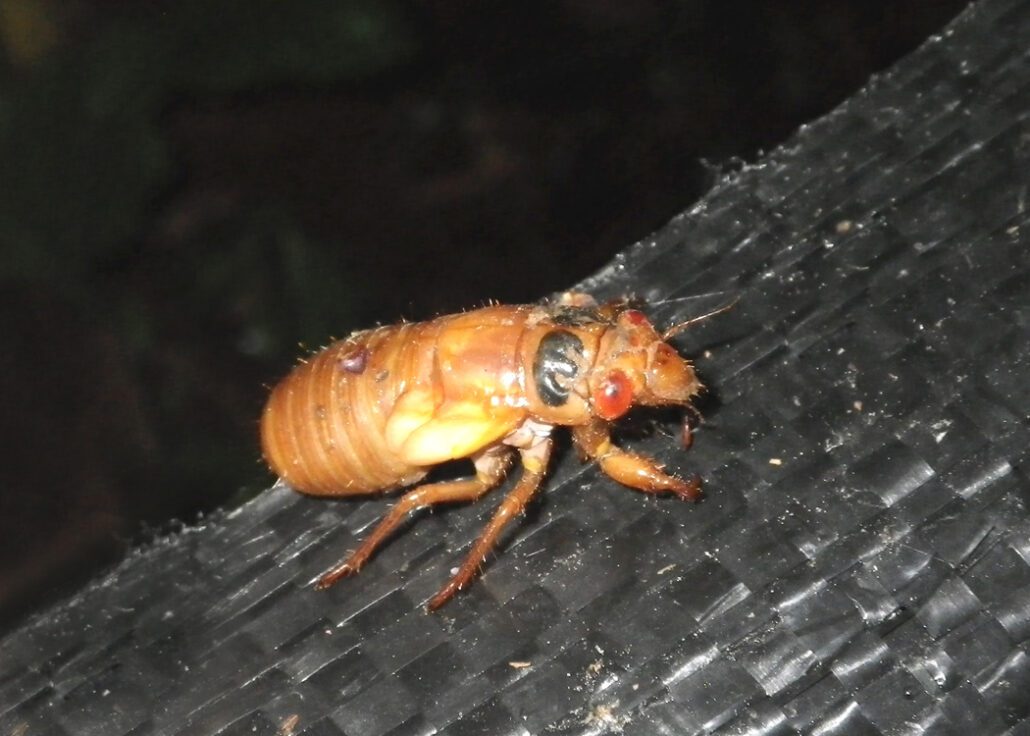
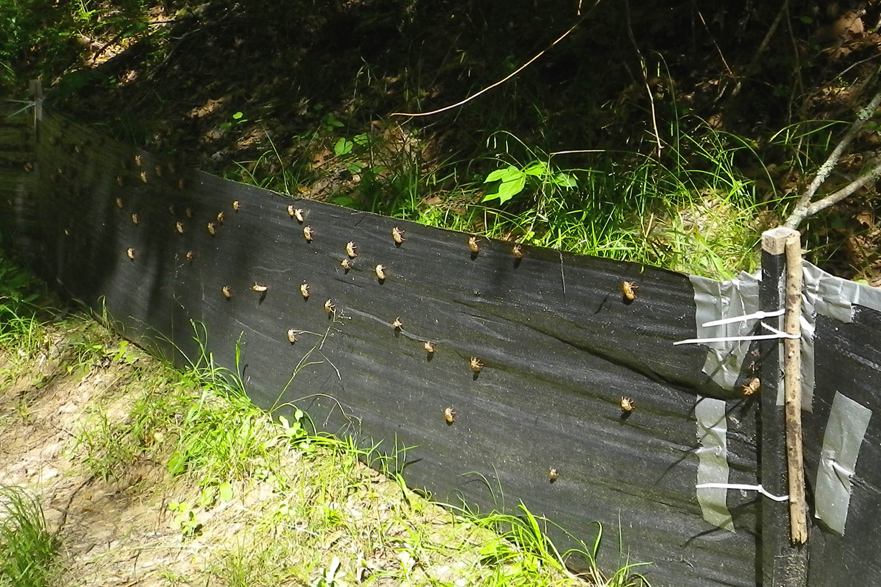
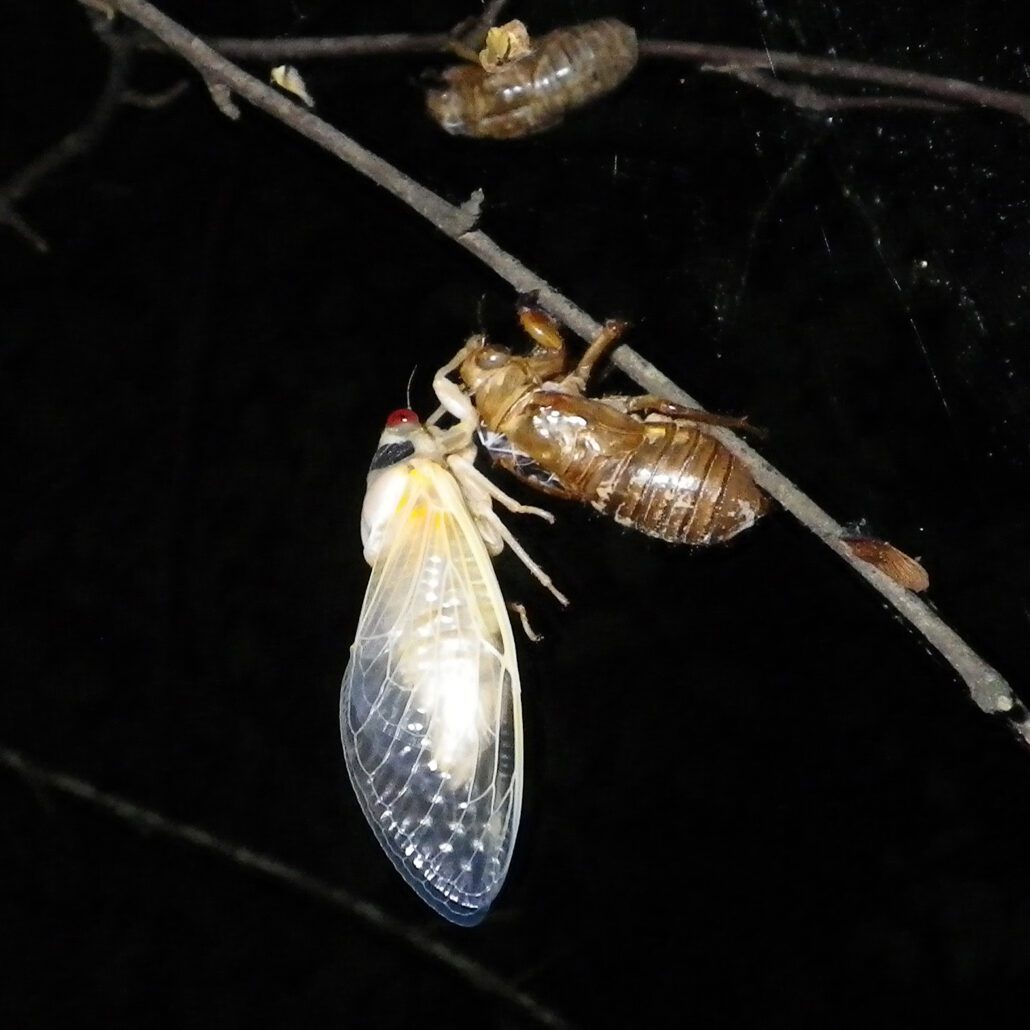
Magicicada is divided into 15 groups called Broods, each designated by a different Roman numeral. Broods are defined not by species but by the synchronicity of their internal clocks, and most emergences involve more than one species https://www.cicadamania.com/cicadas/where-will-17-13-year-periodical-cicadas-emerge-next/.
Masses of male Periodical cicadas gather in the treetops and “sing” by vibrating an internal membrane (tymbal) that’s stretched between the thorax and the abdomen. It vibrates hundreds of times per second and can, depending on the species, produce sounds of nearly 100 decibels (louder than a vacuum cleaner, leaf-blower, blender, or garbage disposal). Between choruses, males make short flights away from the group looking for mates (she flicks her wings at him if she’s in the mood. Female cicadas are silent, but even if she could make sound, he might not hear her in the din). Females lay eggs by drilling into twigs, and when the egg hatches, the nymph (and often the tip of the twig) drops to the ground.
Magicicada nymphs spend their lives about two feet underground, molting five times, and some researchers suggest that they note the passing years by registering that the tree sap is richer in amino acids when the tree blooms in spring (but they don’t know how cicadas “count”). They are transient – starting to emerge at night, in late April, when soil temperature reaches 64 degrees F, and disappearing by mid-July. By then, the nymphs have aerated the soil, the decomposing shells and adults are enriching the soil, and the birds are well-fed.
Conventional wisdom long held that adult cicadas lived briefly and didn’t eat, which wisdom the BugLady imparted to her offspring. She got a phone call one day from one of her daughters, who was out on the trail with a class. She had picked up a cicada to show them, and it had stabbed her in the finger (cicadas, the EPA says, “sometimes mistake us for trees,” and it advises us to “Just remove the cicada from your person, and go about your business”). Adult cicadas feed on plant juices – in fact, they sip 300 times their body weight in plant sap daily.
What goes in must come out, and along that vein, some recent articles have noted that because they must ingest so much nutrient-poor plant sap in order to get enough calories, cicadas are prodigious (and powerful) pee-ers and that no one has studied the impact of all that urine on the landscape (as we say in the Nature business – don’t look up with your mouth open).
Cicada nymphs are eaten by moles, and the adults provide a buffet for snakes, lizards, skunks, rodents, possums, birds of all sizes (the BugLady once heard a truncated cicada buzz and looked out the window to see a (smug) Brown Thrasher leaving the scene with a beakful of cicada), and they are collected and cached by Cicada-killer wasps https://bugguide.net/node/view/1456668/bgimage. A few sources said that when birds concentrate on cicadas in big years, they ignore caterpillars, allowing caterpillar populations to increase. Historically, American Indians fried or roasted cicadas, and today, the emergence of large broods spawns cook-offs among entomophagists.
Part 3: PERIODICAL CICADAS ARE AROUND ALL THE TIME — WHAT’S THE BIG DEAL ABOUT 2024?
Billions of cicadas, that’s what! Enough cicadas to stretch to the moon and back 33 times – more than 15 million miles of cicadas, nose to tail. As many as 1.5 million cicadas per acre, with 20 to 25 exit holes in a square foot of soil. The simultaneous appearance over a 16 state area of two geographically adjacent broods, Brood XIII (the Northern Illinois Brood) and the periodical cicadas with the widest range, Brood XIX (the Great Southern Brood). The simultaneous emergence of two broods – a 13-year species and a 17-year species – that last emerged together when Thomas Jefferson was president and that won’t appear together for another 221 years (by comparison, the next total solar eclipse will occur on August 12, 2026 – OK, 2044 if you insist on staying in North America https://en.wikipedia.org/wiki/List_of_solar_eclipses_in_the_21st_century).
How far will Wisconsin eco tourists will have to travel? Just to our southern border – scroll down for a map: https://www.smithsonianmag.com/smart-news/cicadas-are-coming-rare-dual-emergence-could-bring-one-trillion-of-the-bugs-this-year-180983635/?utm_source=smithsoniandaily&utm_medium=email&utm_campaign=editorial&spMailingID=49350631&spUserID=ODg4Mzc3MzY0MTUyS0&spJobID=2622459374&spReportId=MjYyMjQ1OTM3NAS2.
As always, the question is “Can you get high on Periodical cicadas (beyond the sheer joy of witnessing the exuberance of Nature, of course)? Well —- maybe.
About 5% of Magicicada nymphs may become infected with a fungus called Massospora (a so-called Zombie fungus) that produces both the psychedelic chemical psilocybin (think “magic mushrooms”) and an amphetamine/stimulant called cathinone. The nymphs are exposed when they enter the soil after hatching, or while they’re living underground, or even as they tunnel up to emerge as adults. When the adult matures, its butt falls off and is “replaced” by a white mass of fungal spores https://bugguide.net/node/view/1980876/bgimage – “what entomologists affectionately call ‘flying salt shakers of death,’” says the National Audubon Society website. With the fungus calling the shots, behaviorally, infected adults initiate a lot of romantic encounters, and they often walk along the ground, dragging their nether portions and thereby depositing spores on the soil.
Part 4: CICADA MISCELLANIA
Cicadas aren’t known to carry diseases, but after a Brood XIII emergence in 2007, lots of suburban Chicagoans had nasty, itchy rashes. Turns out that a tiny mite called the Oak gall mite (aka the “itch mite”) eats cicada eggs when it’s not eating Oak leaf gall midges. More cicada eggs = more mites = more human-mite encounters.
During the Brood X emergence a few years ago, a disease was seen in birds in the same geographical area. It was suspected that there was a link to the cicadas that suddenly dominated their diet (biological magnification), but it was not determined whether the problem was the extra load of cicada “meat” itself, chemicals that the nymphs or adults may have been exposed to, or soil bacteria or fungi that came to the surface with the nymphs. The disease eased as the cicadas died off.
History geeks please note the History section of the Wikipedia write-up on Periodical cicadas, documenting cicadas in the early years of our Republic: https://en.wikipedia.org/wiki/Periodical_cicadas.
Learn to make an origami cicada at https://cicadasafari.org/download/foldacic2021.pdf.
And speaking of biological exuberance, our skies are suddenly filled with Red Admiral butterflies (and some Painted Ladies, too) migrating up from the South and Southwest. Early butterflies don’t rely on flowers; they feed on sap dripping from trees.
Kate Redmond, The BugLady
Bug of the Week archives:
http://uwm.edu/field-station/category/bug-of-the-week/
